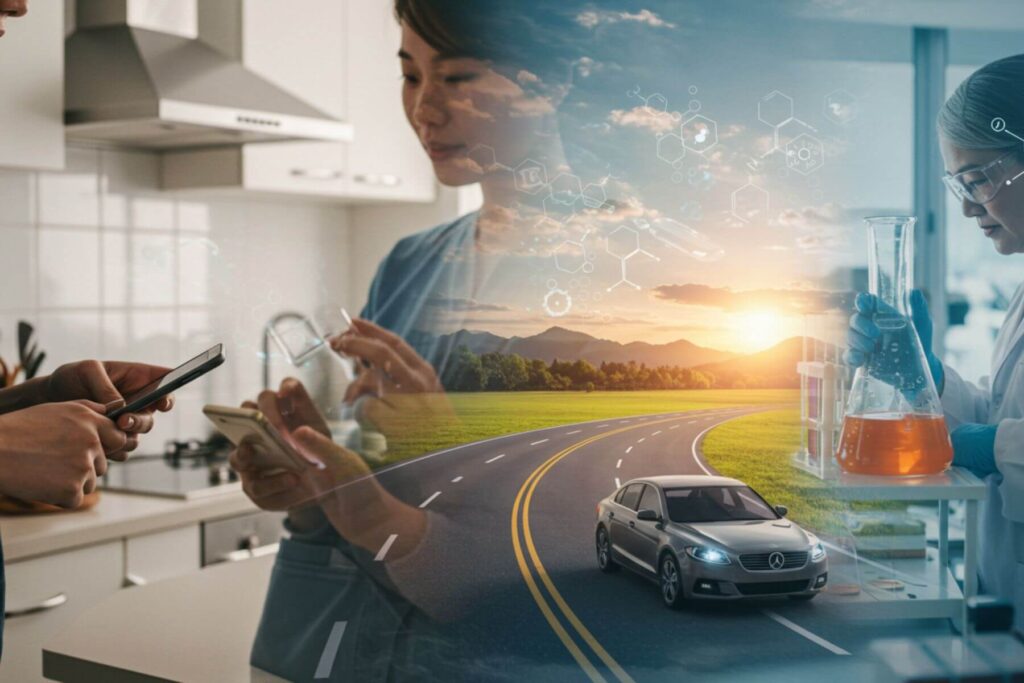Science may seem like something reserved for labs, scientists in white coats, or complex research papers, but in reality, it’s all around us. From the moment you wake up to the time you go to sleep, science is quietly working in the background, making your daily life safer, more convenient, and more enjoyable.
Understanding how science is used in everyday life not only helps you appreciate the world more deeply, but it also shows you the power of knowledge and discovery. In this article, we’ll explore ten fascinating real-life examples of science in action — and you might be surprised how many of them are part of your daily routine.
1. Cooking and baking
One of the most common places where science plays a big role is in the kitchen. Cooking is essentially chemistry. When you bake a cake, for instance, baking soda reacts with an acid to produce carbon dioxide gas, which makes the cake rise. Heating changes the protein structure in eggs and the starch in flour, creating new textures and flavors.
Even boiling water involves science. As water heats up, its molecules move faster and eventually turn into steam at 100°C (212°F). Understanding how temperature, time, and ingredients interact can help you become a better cook and even experiment with your own recipes.
2. Using smartphones and the internet
Every time you send a message, stream a video, or browse the web, you’re relying on physics, computer science, and engineering. Your smartphone uses electromagnetic waves to communicate with cell towers and satellites. Inside the device, microprocessors follow complex logic to process information at lightning speed.
Wi-Fi, Bluetooth, and even the touch screen all work because of scientific principles. The screen detects your finger using changes in electrical conductivity, while apps use algorithms to respond to your inputs. Without decades of scientific research, none of this technology would exist.
3. Driving a car
Driving a car is another excellent example of how science is used in everyday life. Combustion engines rely on chemistry to convert fuel into energy. Physics is involved in every aspect of driving — from acceleration and braking to understanding how friction and gravity affect your movement on the road.
Modern vehicles are filled with science-driven innovations. Anti-lock braking systems (ABS) use sensors and control systems based on physics and engineering principles. GPS navigation systems use satellites orbiting Earth, a direct result of advancements in space science and geolocation technologies.
4. Cleaning and sanitation
The next time you do laundry, wash dishes, or use hand sanitizer, you’re using science to stay clean and healthy. Detergents and soaps work because of chemistry. They contain molecules that are both hydrophilic (water-loving) and hydrophobic (water-repelling). These molecules surround dirt and grease, breaking it apart so it can be rinsed away with water.
Sanitizers and disinfectants are also the products of chemistry. They are carefully formulated to destroy bacteria, viruses, and other pathogens. Even your toothpaste uses science to help fight cavities, thanks to fluoride compounds that strengthen enamel and protect your teeth.
5. Weather forecasting
Checking the weather before heading out for the day is something we all do. But have you ever thought about the science behind those forecasts? Meteorology, the study of weather, involves physics, chemistry, and computer modeling.
Weather satellites collect data on temperature, air pressure, humidity, and wind patterns. This data is then fed into complex models that simulate atmospheric behavior. Thanks to this science, we can anticipate storms, plan our wardrobes, and even avoid dangerous weather conditions — all from our smartphones or TVs.
6. Medicine and healthcare
Science plays a life-saving role in medicine and healthcare. Whether you take over-the-counter pain relievers or undergo a complex surgery, science is behind every step. Pharmaceuticals are developed through extensive research in biology and chemistry. Vaccines are created using knowledge of how viruses work and how the human immune system responds.
Diagnostic tools like X-rays, MRIs, and blood tests are all scientific marvels. They help doctors detect diseases early and accurately. Even something as routine as wearing glasses or using a thermometer relies on scientific principles to work effectively.
7. Agriculture and food production
The food you eat wouldn’t exist without science. From the seeds planted in the ground to the crops harvested and transported to stores, every step of agriculture is optimized with the help of biology, chemistry, and environmental science.
Farmers use fertilizers based on scientific formulations that ensure optimal plant growth. Pesticides are developed to minimize damage from insects and fungi. Scientific breeding techniques create more resilient and nutritious crops. Even irrigation systems are engineered using principles of fluid dynamics and environmental science to ensure efficient water usage.
8. Transportation and public transit
Whether you ride a bus, take the subway, or board an airplane, science is the foundation that keeps public transportation systems running. Engineers apply physics and materials science to build safe and efficient vehicles. Aerodynamics allows airplanes to lift off the ground, while electricity powers many modern subway systems.
GPS and traffic control systems use data science and geolocation technologies to optimize routes and schedules. Even the timing of traffic lights is controlled using mathematical algorithms to reduce congestion and improve safety.
9. Electricity and lighting
Every time you flip a switch, you’re using one of the most impactful discoveries in science: electricity. The flow of electrons through wires powers everything from your refrigerator to your television. Thomas Edison’s invention of the lightbulb was just the beginning — today’s LED and smart lighting systems are the result of years of innovation in electrical engineering and physics.
Even your power supply — whether it comes from fossil fuels, solar panels, wind turbines, or nuclear reactors — involves complex scientific principles. Science allows us to generate, store, and distribute electricity safely and efficiently.
10. Exercise and body movement
Science even plays a role in how we move our bodies and stay healthy. Exercise physiology is the scientific study of how physical activity impacts body systems. When you lift weights, run, or do yoga, your muscles, heart, lungs, and brain all respond in ways that have been extensively studied.
Wearable fitness trackers use sensors and algorithms to monitor your steps, heart rate, and sleep cycles. Nutrition science informs us about the kinds of foods and diets that best support an active lifestyle. And biomechanics — a branch of science that studies movement — helps improve everything from athletic performance to physical therapy treatments.
Bottom line
Science is everywhere. It’s in the food you eat, the phone you use, the car you drive, and even the soap you wash your hands with. By appreciating the role of science in everyday life, you gain a deeper respect for the invisible forces shaping our world.
Next time you’re cooking dinner, taking a shower, or sending a text message, take a moment to think about the incredible scientific discoveries that make those actions possible. The more you notice them, the more you realize just how amazing — and essential — science really is.



